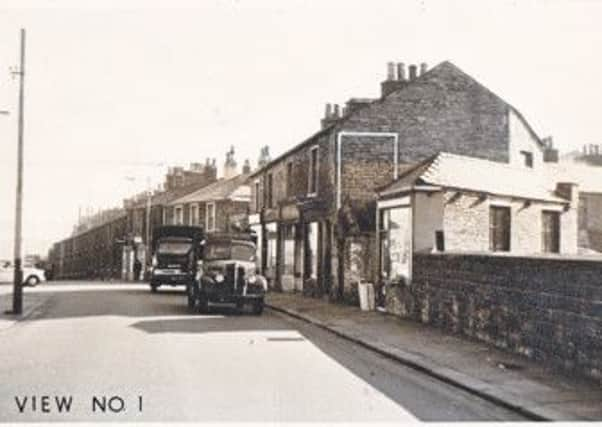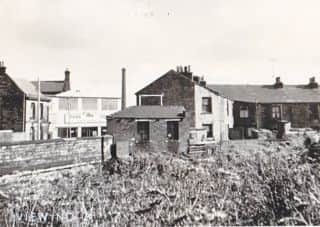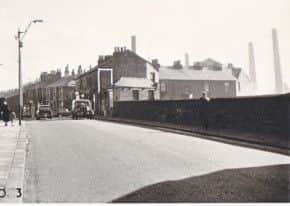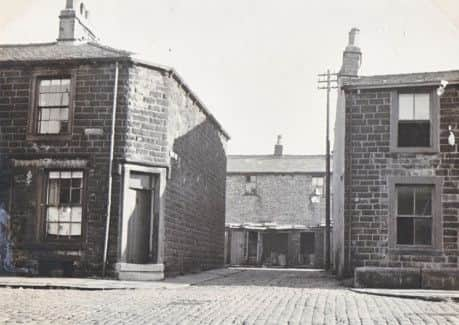The motor industry boom in Burnley


The images I use today come from Burnley Council’s Engineers and Surveyors Department which, at the time the pictures were taken, was headed by Mr A.G. Richardson.
The four images were taken in the 1950s and three of them refer to the time when the council was regularising the locations of advertising hoardings and, if you look at the pictures carefully, you will see an engineer has marked on the photo the location of an intended board.
View No 1 tells us where we are.


Advertisement
Hide AdAdvertisement
Hide AdTo the right is Accrington Road railway bridge with, in the middle distance, the crossroads formed by the junctions of Accrington Road, Sandygate, to the right, and Barracks Road, to the left.
The image, entitled “View No 3” confirms this and View Number 2 adds further information.
I am going to start with View No 1. I know the Angel Inn is at 80, Accrington Road. You can see this behind the second of the two vehicles to the right in the photo.
The row of shops, again to the right, started on the other side of Sandygate and the first of them, number 82, was a branch of Hartley’s chemists, with living accommodation behind, until 1952 when the shop closed.


Advertisement
Hide AdAdvertisement
Hide AdIn 1953 we findthe property was occupied by Mr John Cook but I remember the building very well as the late Mr John Parkinson, the educational bookseller, had his premises here once he took the business over from Lupton’s, the Burnley-based general booksellers. Incidentally, I will write about Lupton’s in a future article as the Briercliffe Society has recently bought some old photos of shops owned by the firm.
There is, though, another book connection with this property which I will deal with in a moment but, before I leave 82, let me explain my involvement.
When I was a teenager I was offered a Saturday job at Lupton’s in St James’s Street. It had been arranged by my father whose position at Burnley Town Hall meant he often worked with John Parkinson. They became good friends but John, then manager of Lupton Bros, wanted someone to work on Saturdays and as relief in the school holidays.
My dad probably thought that as his first job had been in a town centre shop, Webster’s the Burnley department store, this was a good starting point for me. I have to say I really enjoyed working at Lupton’s St James’s Street book shop, the busy branch in the Market Hall and the shop in Scotland Road, Nelson.


Advertisement
Hide AdAdvertisement
Hide AdLupton’s had another shop, in Church Street, Burnley. It was here the educational department could be found and I soon found myself working there. The jobs were to prepare orders for delivery to schools mainly in Burnley but later in Blackburn. When delivering I got to know parts of both towns I would not otherwise have seen, so for this I have this to thank John.
When Lupton’s closed their big St James’s Street shop, and moved to Keirby Walk, a mistake in my view, it was resolved the educational side of the business would close. It was then John put in a bid securing this side of the business and moving it to 82 Accrington Road. We only had the former chemist’s shop. All the shelving was still in place and they were soon heaving with books destined for Burnley’s school children.
I ought to explain that education book supplying is very different to book selling. An educational book supplier, when not dealing with school library books (the most interesting part of the business so far as I was concerned), took orders for classroom sets, usually about 36 copies of a text book, plus teachers notes and, sometimes, other information – posters, slides, photos etc. I refer to the days before each classroom was filled with computers!
As an aspiring teacher, and writer, I found a lot of what was arriving on a daily basis at Accrington Road, of great interest and often wish I had made notes on some of the titles. One was a small geography book in which the authors had undertaken a study of Burnley cotton industry mapping all the mills, when they were built, what processes were carried out in them and how the buildings were used in the 1960s after King Cotton had been usurped.
Advertisement
Hide AdAdvertisement
Hide AdI suppose I could have produced such a book but the amount of work that had gone into it was very daunting even for me. Of course, it was not the only book I could have used for years to come. I read lots of history textbooks which gave me many ideas which I implemented in my own teaching career. With a colleague I designed courses for my pupils on archaeological discoveries like that of the Poulton Elk (1970) and St Bee’s Man (1980) and, pinching ideas from all over the place, I wrote a textbook on Roman England which is still being used in some schools today 30 years after it was made available.
Number 84 Accrington Road was occupied by a Miss Beatrice Hellier, a confectioner, but I do not think the shop was open when I worked (part-time) at 82.
If it had been, I am sure I would have been in to test her cakes and pies against those my mother made at home. John and I usually got fish and chips, or a Chinese meal, at the little takeaway opposite 82, but in Sandygate. Last time I looked it was still there.
You could see number 86 had formerly been a butchers but when I knew these buildings the branch of Dewhurst’s which had formerly operated from here had also closed.
However, at 88, there was another bookseller’s.
Advertisement
Hide AdAdvertisement
Hide AdThis was Edward Brownwood who also had premises at 107a Accrington Road. If I remember correctly Mr Brownwood dealt in second-hand books and I only just remember the shop because, occasionally, there were books displayed on pavement shelving.
If you look at View No 1 you will see there is a small detached building just before the railway bridge. These premises are now a well-known takeaway but I remember them occupied by a boot and shoe repairer, Ernest Richardson. Above his shop, on the wall of the booksellers, is the mark made by the engineer. This was to show where a hoarding for posters would have been erected had the council agreed to an application.
The car in View No 1 is a Sunbeam Rapier, one of the vehicles to which I aspired when I was at school, but it leads me to View No 2. This adds a little to what we already know. However, apart from the General Havelock, on the corner of Barracks Road, you can see two other interesting buildings. The first is part of Burnley Barracks; the roof above the pub and the building painted white.
This latter is, and many of you, given its name, will be surprised at this, the premises of Bank Top Motor House, Burnley’s Ford agents. Previous to this they had been in Railway Street, in the Bank Top area of Burnley from where the company name derived. There they had occupied Bank Top Carriage Works which had been home to John Knape Ltd, Burnley motor body builders who built Burnley’s first buses in 1924.
Advertisement
Hide AdAdvertisement
Hide AdBefore the arrival of the Motor House in Accrington Road this building had been occupied by Leyland Motors as their East Lancashire Depot. People forget about the importance to Burnley of the motor industry. It was not only that a number of companies, including Lucas’s, made parts and accessories for vehicles of different descriptions, Burnley, at one time actually made vehicles.
In addition, there were a large number of firms which were agents for British and foreign producers of vehicles. In 1953, for instance, there were 22 motor car dealers and agents including such well-known firms as Hebden Bros, who were also in Accrington Road; Holden and Hartley, in Church Street; Rushworth’s in Bull Street and Skipper’s, who were then in Oxford Road. In addition, there were three motor cycle agents and a large number of motor garage proprietors, dismantlers and motor haulage contractors.
The motor industry, in its various guises, was big in Burnley but things have changed. Recently we have lost a Renault dealer and Lookers, who occupied the site seen in View No 2.
This leaves us with to deal with View No 3 which introduces a few tall chimneys into the equation. I feel those on the extreme right might refer to the sanitary ware and pipe factory of J. Duckett and Son Ltd. in Blannel Street. Not sure as to who might claim the other two but Trafalgar is not so far away so they might relate to firms in that area.
Advertisement
Hide AdAdvertisement
Hide AdTo conclude this part of the article, I want to point out I feel that, even though I am a member of it, the council has made a bit of a pig’s ear with regard to the road system in this part of town. View No 3 shows the wide Accrington Road I remember: quite a pleasant driving experience.
I have included a fourth picture. It is of Vicarage Place, off Accrington Road, as it was in October, 1956. Vicarage Place was off 123 Accrington Road and I used to like looking around this part of town. The houses might not have been all that salubrious but we lost a real community when this area was demolished.